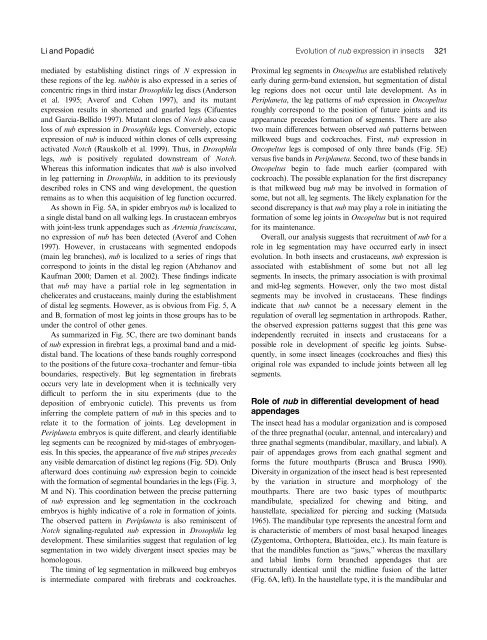Li&Popadic 2004.pdf - Biological Sciences Home - Wayne State ...
Li&Popadic 2004.pdf - Biological Sciences Home - Wayne State ...
Li&Popadic 2004.pdf - Biological Sciences Home - Wayne State ...
Create successful ePaper yourself
Turn your PDF publications into a flip-book with our unique Google optimized e-Paper software.
Li and <strong>Popadic</strong>Łmediated by establishing distinct rings of N expression inthese regions of the leg. nubbin is also expressed in a series ofconcentric rings in third instar Drosophila leg discs (Andersonet al. 1995; Averof and Cohen 1997), and its mutantexpression results in shortened and gnarled legs (Cifuentesand Garcia-Bellido 1997). Mutant clones of Notch also causeloss of nub expression in Drosophila legs. Conversely, ectopicexpression of nub is induced within clones of cells expressingactivated Notch (Rauskolb et al. 1999). Thus, in Drosophilalegs, nub is positively regulated downstream of Notch.Whereas this information indicates that nub is also involvedin leg patterning in Drosophila, in addition to its previouslydescribed roles in CNS and wing development, the questionremains as to when this acquisition of leg function occurred.As shown in Fig. 5A, in spider embryos nub is localized toa single distal band on all walking legs. In crustacean embryoswith joint-less trunk appendages such as Artemia franciscana,no expression of nub has been detected (Averof and Cohen1997). However, in crustaceans with segmented endopods(main leg branches), nub is localized to a series of rings thatcorrespond to joints in the distal leg region (Abzhanov andKaufman 2000; Damen et al. 2002). These findings indicatethat nub may have a partial role in leg segmentation inchelicerates and crustaceans, mainly during the establishmentof distal leg segments. However, as is obvious from Fig. 5, Aand B, formation of most leg joints in those groups has to beunder the control of other genes.As summarized in Fig. 5C, there are two dominant bandsof nub expression in firebrat legs, a proximal band and a middistalband. The locations of these bands roughly correspondto the positions of the future coxa–trochanter and femur–tibiaboundaries, respectively. But leg segmentation in firebratsoccurs very late in development when it is technically verydifficult to perform the in situ experiments (due to thedeposition of embryonic cuticle). This prevents us frominferring the complete pattern of nub in this species and torelate it to the formation of joints. Leg development inPeriplaneta embryos is quite different, and clearly identifiableleg segments can be recognized by mid-stages of embryogenesis.In this species, the appearance of five nub stripes precedesany visible demarcation of distinct leg regions (Fig. 5D). Onlyafterward does continuing nub expression begin to coincidewith the formation of segmental boundaries in the legs (Fig. 3,M and N). This coordination between the precise patterningof nub expression and leg segmentation in the cockroachembryos is highly indicative of a role in formation of joints.The observed pattern in Periplaneta is also reminiscent ofNotch signaling-regulated nub expression in Drosophila legdevelopment. These similarities suggest that regulation of legsegmentation in two widely divergent insect species may behomologous.The timing of leg segmentation in milkweed bug embryosis intermediate compared with firebrats and cockroaches.Evolution of nub expression in insects 321Proximal leg segments in Oncopeltus are established relativelyearly during germ-band extension, but segmentation of distalleg regions does not occur until late development. As inPeriplaneta, thelegpatternsofnub expression in Oncopeltusroughly correspond to the position of future joints and itsappearance precedes formation of segments. There are alsotwo main differences between observed nub patterns betweenmilkweed bugs and cockroaches. First, nub expression inOncopeltus legs is composed of only three bands (Fig. 5E)versus five bands in Periplaneta. Second, two of these bands inOncopeltus begin to fade much earlier (compared withcockroach). The possible explanation for the first discrepancyis that milkweed bug nub may be involved in formation ofsome, but not all, leg segments. The likely explanation for thesecond discrepancy is that nub mayplayaroleininitiatingtheformation of some leg joints in Oncopeltus but is not requiredfor its maintenance.Overall, our analysis suggests that recruitment of nub for arole in leg segmentation may have occurred early in insectevolution. In both insects and crustaceans, nub expression isassociated with establishment of some but not all legsegments. In insects, the primary association is with proximaland mid-leg segments. However, only the two most distalsegments may be involved in crustaceans. These findingsindicate that nub cannot be a necessary element in theregulation of overall leg segmentation in arthropods. Rather,the observed expression patterns suggest that this gene wasindependently recruited in insects and crustaceans for apossible role in development of specific leg joints. Subsequently,in some insect lineages (cockroaches and flies) thisoriginal role was expanded to include joints between all legsegments.Role of nub in differential development of headappendagesThe insect head has a modular organization and is composedof the three pregnathal (ocular, antennal, and intercalary) andthree gnathal segments (mandibular, maxillary, and labial). Apair of appendages grows from each gnathal segment andforms the future mouthparts (Brusca and Brusca 1990).Diversity in organization of the insect head is best representedby the variation in structure and morphology of themouthparts. There are two basic types of mouthparts:mandibulate, specialized for chewing and biting, andhaustellate, specialized for piercing and sucking (Matsuda1965). The mandibular type represents the ancestral form andis characteristic of members of most basal hexapod lineages(Zygentoma, Orthoptera, Blattoidea, etc.). Its main feature isthat the mandibles function as ‘‘jaws,’’ whereas the maxillaryand labial limbs form branched appendages that arestructurally identical until the midline fusion of the latter(Fig. 6A, left). In the haustellate type, it is the mandibular and




